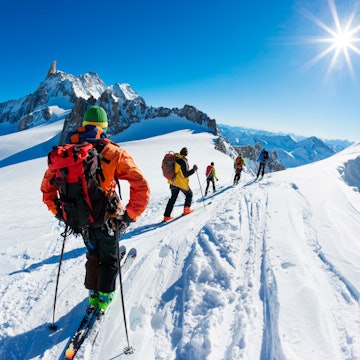

The festivals that celebrate the Swiss cows and their herders each year are a sight to behold © Andreas Mueller via Swiss Image Bank
Cows might be holy in India, but they certainly have their own pride of place in the Swiss mountain landscape. Each spring, the bovine beauties journey from their valley barns, up to the alpine fields some 5,000 feet higher, where they spend their summers leisurely grazing – and producing milk. Swiss dairy farmers swear the higher altitude, not to mention the flowers and herbs the cows munch on, are responsible for the superior Swiss dairy products. But more than just a food source, Swiss cows are the country's unofficial national animal and an integral part of Switzerland's culture.
Here are five ways to celebrate the iconic Swiss cow:

1. Eat Swiss cheese
Most of us are familiar with Swiss cheese – the kind with the holes in it. What you probably don’t know, however, is that there are more than 450 kinds of Swiss cheese, ranging from the famous Emmental to lesser-known regional varieties.
The perfect place to learn more about cheese and the mighty Swiss cow is Gstaad. Also on the map as a famous Alps ski-resort town, Gstaad has 200 farms, 80 working Alpine pastures and approximately 7,000 cows. Here, you can tap into the Swiss Farmers Welcome You campaign for a Swiss cow dairy tour or to see some traditional Swiss cheese-making.
Following the centuries’ old tradition, farmers in most Alps regions hire cheese-makers to go up to the mountain stables with the cows in the summer. After that, the cheese is stored and sold by local village cooperatives like Molkerei Gstaad. A tour of Molkerei takes you 82 feet underground into a cheese grotto filled with more than 3,000 wheels of sublime aging cheese. The specialty? Sliced and rolled Hobelkase cheese, a traditional Alps cheese with strict rules on how it’s produced.

2. Indulge in a Swiss cheese fondue
Of course, there's a cheese fondue restaurant in almost every Swiss town. A perfect example is Restaurant Stubli in the Posthotel Rossli in Gstaad, a traditional chalet-style pub and restaurant built in 1823, where a server clad in traditional dirndl-style attire will serve you a bubbling cheese fondue with thick chunks of heavy Swiss bread and potatoes for dipping.
Another cheese dish you will see on every Swiss menu is raclette. For the perfect taste of this semi-hard cheese melted over potatoes, head over some mountains and down the train tracks to Walliserstuba in Brig, an Alpine village in the Valais region, where they have special raclette evenings every week.
If you want to indulge in a fondue in the open air, pick up a "fondue backpack," complete with required ingredients and utensils, from a Swiss cow dairy in Gstaad, then wander to one of the five specially-designed huts in the region that look like a giant fondue pot. Guaranteed the warm, melted cheesy-goodness will taste even better with the prime mountain (and likely some Swiss cows) views.
Related: Cheese-rolling to shin-kicking: the most unbelievable sports events on earth
The foodie's guide to St Moritz, Switzerland

3. Hike in the Swiss Alps
When you hike in the Alps, you will be wandering along centuries-old trails past lakes, meadows and mountain huts among – you guessed it – Swiss cows. With numerous gondolas up into the mountains, hiking the Alps is accessible to all, no matter your fitness level.
For some stellar glacier views, catch the train to Morel in Valais, where a series of cable cars whisk you up to the Aletsch Glacier, the longest in the Alps. An easy hike back along the Panorama Ridge Trail will take you past lush grassy slopes dotted with wildflowers, grazing Swiss cows (listen for the tinkling of the bells they wear around their necks — this is the signature sound of Switzerland), and plenty of benches to take a break and admire the snow-covered peaks in the distance.
Of course, you’ll want to try some more Swiss cheese, so before you take the gondola back down, stop at Restaurant Derby in Riederalp, for a melted-cheese sandwich and a Rivella, a uniquely Swiss drink made from milk whey.

4. Eat Swiss milk chocolate
Switzerland is also famous for its superior Swiss milk chocolate, and the smooth, delicious milk chocolate we know today was invented there. On a stroll along the Bahnhofstrasse in Zurich, the world's most expensive street, there are numerous distinguished chocolatiers like Lindt, Toblerone, and Cailler, the oldest chocolate manufacturer in Switzerland. Most of the chocolatiers in Zurich sprang up in the late 1800s, but more recently, chocolate makers like Taucherli have started a bean-to-bar trend, where every step of the crafting is done in-house.
For a truly Swiss experience, stop for a hot chocolate at Sprungli’s first floor café overlooking the Paradeplatz, opened in 1859. Then, for complete chocolate-immersion, visit Bachmann. You will think you’re in a Swiss chocolate Shangri-La as you ascend a glass staircase with chocolate flowing under it to Chocolate World, a chocolate buffet with a 215 square-foot flowing-chocolate wall. The deep chocolate fragrance is intoxicating.

5. Go to a Swiss cow festival
When the Swiss cows come back down to the valleys in the fall, Alpine villages like Appenzell and Gstaad celebrate these magnificent creatures with traditional festivals filled with food, drink, yodeling, and mountain prayers. Led by cow herders carrying massive cow bells over their shoulders and dressed in embroidered traditional outfits, the beautiful bovines prance through town like beauty queens, adorned with tinkling cow bells and wildflower garlands and headpieces.















